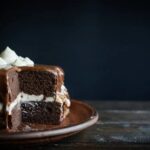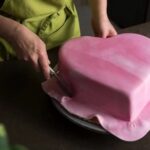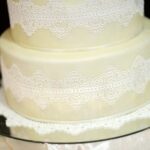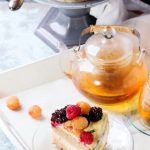Are you looking to add a touch of sweetness and artistry to your baked creations? Learning how to decorate a cake with icing sugar is the perfect way to elevate your confectionary skills and impress your friends and family.
Whether you’re a seasoned baker or a novice in the kitchen, mastering the art of cake decoration with icing sugar opens up a world of creative possibilities. In this article, we’ll guide you through the process of transforming a simple cake into an eye-catching masterpiece using this versatile and delicious decorating medium.
Cake decorating with icing sugar is not just about making a sweet treat look pretty – it’s about expressing your creativity and adding a personal touch to your baked goods. With the right tools and techniques, you can turn a plain cake into a work of art that will delight both the eyes and the taste buds. From simple designs to intricate patterns, there are endless ways to use icing sugar to adorn your cakes and make them truly special.
In the following sections, we will provide you with everything you need to know to get started on your journey into the world of cake decoration with icing sugar. We’ll cover essential tools and ingredients, step-by-step guides for preparing the cake and making the perfect icing sugar, exploring different decorating techniques, insider tips for success, troubleshooting common issues, and final presentation tips.
So, whether you’re planning to bake for a special occasion or simply want to hone your baking skills, read on as we take you through all you need to know about decorating cakes with icing sugar.
Tools and Ingredients
Decorating a cake with icing sugar can be a delightful and creative process, but it’s important to have the right tools and ingredients on hand to ensure success. Before venturing into the world of cake decoration, it’s essential to gather everything you need to bring your vision to life. Here is a comprehensive list of the necessary tools and ingredients for decorating a cake with icing sugar.
When it comes to tools, you will need piping bags and tips for creating intricate designs, offset spatulas for smooth application of icing sugar, a turntable for easy maneuvering while decorating, and a bench scraper for achieving clean edges. Additionally, having a variety of stencils, molds, and cutters can add depth and dimension to your cake decorations.
In terms of ingredients, high-quality icing sugar is paramount for achieving a smooth and flawless finish. Other essential ingredients include gel food coloring for vibrant hues, clear vanilla extract or other flavorings if desired, and meringue powder or egg whites for making sturdy royal icing.
It’s also important to have different types of sprinkles, edible glitter, and decorative elements on hand to add flair to your cake designs. With the right tools and ingredients at your disposal, you’ll be well-equipped to embark on an exciting journey into the art of cake decoration with icing sugar.
Preparing the Cake
When it comes to decorating a cake with icing sugar, proper preparation of the cake itself is key. Before you begin applying any decorative elements, it’s essential to ensure that your cake is properly leveled and coated to create a smooth surface for your icing sugar design.
Start by allowing your cake to cool completely before you begin preparing it for decoration. Once cooled, use a serrated knife to carefully level the top of the cake, creating an even surface for decorating. This step is crucial as it ensures that your icing sugar design will be evenly distributed across the entire cake.
After leveling the cake, it’s time to apply a thin layer of crumb coat. A crumb coat is a thin layer of icing that helps seal in any loose crumbs on the surface of the cake, preventing them from mixing into your final layer of icing sugar. Use a offset spatula to spread a thin, even layer of icing over the entire cake, then allow it to set before continuing with your decorative icing sugar design.
Properly preparing your cake by leveling and crumb coating it will ultimately result in a more professional and visually appealing finished product. Taking the time to prepare your cake properly sets the stage for successful and beautiful decoration with icing sugar.
| Preparation Technique | Description |
|---|---|
| Leveling | Use a serrated knife to even out the top of the cake |
| Crumb Coating | Apply a thin layer of icing to seal in any loose crumbs on the surface |
Making the Icing Sugar
Making the perfect icing sugar for cake decoration is an essential part of the cake decorating process. Whether you’re a beginner or a seasoned baker, having the right consistency and flavor in your icing sugar can make all the difference in the final presentation of your cake. Here’s a step-by-step guide to making the perfect icing sugar for cake decoration:
1. Choose the right ingredients: To make icing sugar, you’ll need confectioners’ sugar, also known as powdered sugar, and other flavoring agents such as vanilla extract or citrus zest if desired.
2. Sift the confectioners’ sugar: Sifting the confectioners’ sugar is crucial in achieving a smooth and lump-free texture for your icing. Use a fine-mesh sieve to sift the powdered sugar into a mixing bowl.
3. Add flavoring and liquid: Once you have sifted the confectioners’ sugar, add a small amount of your chosen flavoring agent, such as vanilla extract, along with a little bit of liquid – this could be water, milk, or citrus juice depending on your preference and recipe requirements.
4. Mix to desired consistency: Gradually mix the ingredients together until you achieve the desired consistency for your icing sugar. If it’s too thick, add more liquid; if it’s too thin, add more confectioners’ sugar until you reach the perfect balance.
By following these steps and paying attention to detail, you can create the perfect icing sugar for decorating cakes that will impress any guest or customer. Experiment with different flavors and consistencies to find what works best for your specific cake decorating needs.
Decorating Techniques
When it comes to decorating a cake with icing sugar, there are numerous techniques that can be used to create stunning designs and decorations. Here are some popular decorating techniques that you can try for your next cake project:
- Piping: Piping is a classic cake decorating technique that involves using a pastry bag and various piping tips to create intricate designs, borders, and lettering on the cake. From simple swirls to elaborate floral patterns, the possibilities with piping are endless. To get started, make sure to have a selection of piping tips in different shapes and sizes, as well as a steady hand for precise control.
- Flooding: Flooding is a technique commonly used in cookie decorating, but it can also be adapted for cakes. This method involves outlining a design on the cake with royal icing and then filling it in with a thinner icing consistency known as flood icing. This creates smooth and seamless designs that can be used for creating colorful backgrounds or adding detailed motifs to the cake.
- Stenciling: Stenciling is another fun way to decorate a cake with icing sugar. Simply place a stencil over the surface of the cake and use an offset spatula or palette knife to spread icing over the stencil openings. When you carefully lift off the stencil, you’ll reveal a beautifully detailed pattern or image on the cake. Stenciling is great for adding texture and visual interest to your cake decorations.
These are just a few examples of the many decorating techniques that can be used with icing sugar to elevate your cakes to professional-level works of art.
If you’re looking forward to experimenting with these techniques at home ensure you have all necessary tools such as pastry bags, piping tips stencils of different sizes ensuring you have designs suitable for your baking needs before starting this lovely endeavour.
Tips for Success
Consistency Is Key
When working with icing sugar for cake decoration, achieving the perfect consistency is crucial. Too thin, and the icing will not hold its shape when piped or spread on the cake. Too thick, and it will be difficult to work with and may not spread evenly.
To achieve the ideal consistency, start with a small amount of liquid (such as water or milk) and gradually add more until the desired texture is reached. This way, you can have better control over the final outcome of your cake decoration.
Color Mixing Techniques
Creating beautiful decorations often involves using different colors of icing sugar. To achieve specific shades, it’s essential to know how to mix colors effectively. Start by using gel food coloring in small amounts, as this allows for better color control compared to liquid food coloring. Mix the colors in small bowls or containers before adding them to your icing sugar, enabling you to achieve consistent shades for your decorations.
Practice Makes Perfect
Like any skill, mastering cake decoration with icing sugar takes practice. Don’t be discouraged if your first attempts are not perfect – keep practicing and experimenting with different techniques. Watch tutorial videos, take a decorating class, or study professional cake designs for inspiration. The more you practice, the more confident and skilled you will become in creating beautifully decorated cakes adorned with icing sugar.
These insider tips can help you elevate your cake decoration skills using icing sugar to achieve professional-looking results that will impress friends and family alike. Remember that patience and practice are key components of success in this delicious art form.
Troubleshooting
When working with icing sugar for cake decoration, it is not uncommon to encounter some common issues that can affect the final outcome of the decorated cake. One of the most common problems is air bubbles in the icing sugar, which can result in an uneven or bumpy surface on the cake.
To troubleshoot this issue, gently tap the cake on a flat surface to help release any trapped air bubbles. Additionally, using a toothpick to carefully puncture and smooth out any visible air bubbles can also help create a smoother finish.
Another common issue when working with icing sugar is color consistency. Achieving a uniform color for the icing sugar can be challenging, especially when tinting it with food coloring. To troubleshoot this problem, it’s important to ensure that the food coloring is thoroughly mixed into the icing sugar until the desired hue is achieved. Gradually adding small amounts of food coloring at a time and mixing well can help prevent streaks or uneven coloring in the icing sugar.
Furthermore, another issue that may arise when decorating a cake with icing sugar is the frosting becoming too runny or too stiff. If the frosting is too runny, adding more confectioners’ sugar can help thicken it. On the other hand, if the frosting is too stiff, incorporating a small amount of liquid such as milk or water can help loosen it up to achieve the desired consistency.
| Common Issues | Troubleshooting Tips |
|---|---|
| Air bubbles in icing | Gently tap cake on flat surface and use toothpick to puncture and smooth out air bubbles |
| Inconsistent color | Thoroughly mix food coloring into icing sugar in small increments to achieve uniform color |
| Frosting too runny or too stiff | Add more confectioners’ sugar for thickening or a small amount of liquid (milk/water) for loosening |
Final Presentation
Choosing the Right Display Stand
When it comes to presenting a beautifully decorated cake, the right display stand can make all the difference. Consider the theme and style of the cake when selecting a stand.
For example, a modern and sleek cake may look best on a simple, clear acrylic stand, while a more traditional or rustic cake could benefit from a wooden pedestal stand. Additionally, be sure to choose a stand that is sturdy enough to support the weight of the cake and won’t wobble or tip over.
Adding Decorative Elements
To further enhance the visual impact of the decorated cake, consider adding some decorative elements around the base of the display stand. Fresh flowers, edible pearls, or colored sugar crystals can create an eye-catching border for the cake. Just be sure that any decorations used are food-safe and complement the overall design of the cake.
Lighting and Background
When presenting a decorated cake, lighting and background play important roles in maximizing visual impact. Positioning the cake near natural light or using strategically placed spotlights can help highlight its details and colors. Additionally, consider placing the cake against a backdrop that complements its design.
For example, a dark background can make bright-colored decorations pop, while a neutral backdrop can allow intricate designs to take center stage. Paying attention to these details can elevate the overall presentation of the decorated cake.
Conclusion
In conclusion, decorating a cake with icing sugar can be a fun and rewarding experience for both novice and experienced bakers. By following the tips and techniques outlined in this article, anyone can create stunning and professional-looking cake decorations that are sure to impress. From preparing the cake to making the perfect icing sugar and mastering various decorating techniques, there are plenty of opportunities to get creative and experiment with different designs and styles.
It’s important to remember that practice makes perfect when it comes to cake decoration with icing sugar. Don’t be discouraged if your first attempts don’t turn out exactly as you envisioned – the key is to keep trying and learning from any mistakes along the way. With dedication and patience, you’ll soon feel confident in your ability to create beautiful and delicious works of edible art.
So, whether you’re preparing for a special occasion or simply looking for a new hobby to explore, why not give cake decoration with icing sugar a try? With the right tools, ingredients, and techniques at your disposal, the possibilities are endless. Get ready to unleash your creativity and wow your friends and family with your newfound cake decorating skills.
Frequently Asked Questions
Can You Use Icing Sugar to Decorate a Cake?
Yes, icing sugar can be used to decorate a cake. It’s a commonly used ingredient for making decorative icings and frostings because of its fine texture and ability to create a smooth finish.
How Do You Ice a Cake With Icing Sugar for Beginners?
For beginners, icing a cake with icing sugar can be done by sifting the sugar over the top of the cake and using a flat spatula to gently spread it out evenly. Another method is to mix the icing sugar with a liquid (such as water or milk) to create a thicker glaze that can be poured over the cake.
Do You Put Powdered Sugar on Warm or Cool Cake?
Powdered sugar should be put on a cool cake rather than a warm one. Placing powdered sugar on a warm cake will cause it to dissolve and disappear, whereas applying it on a cooled cake allows it to adhere and create a decorative finish.

Welcome to my blog about home and family. This blog is a place where I will share my thoughts, ideas, and experiences related to these important topics. I am a stay-at-home mom with two young children. I hope you enjoy reading it! and may find some helpful tips and ideas that will make your home and family life even better!





